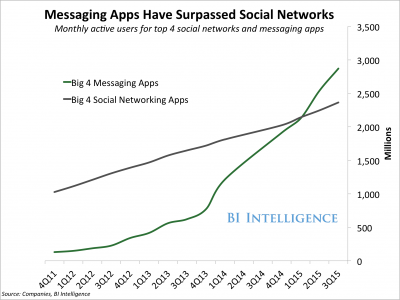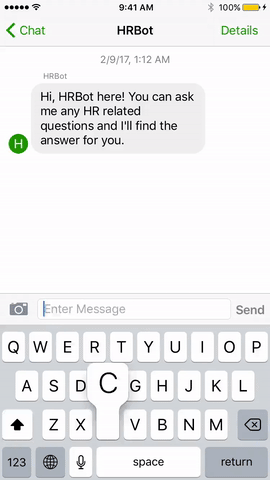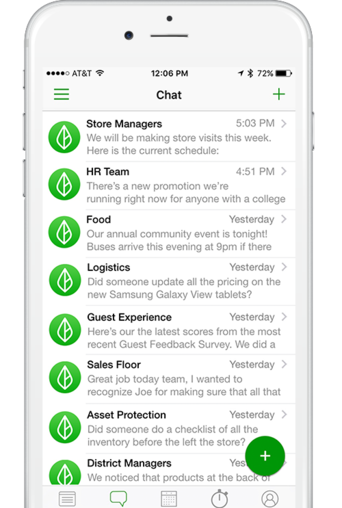There’s been a lot of talk about how chatbots can be used to provide a better experience for customers. Unsatisfied customers are rarely repeat customers, which is why chatbots are rising in popularity for customer service — queries are answered accurately and immediately.
But what about using chatbots to improve the employee experience? This kind of artificial intelligence (AI) is already saving employers big bucks. A report from Juniper Research forecasts that this technology could save businesses $8 billion annually worldwide by 2022, up from the $20 million employers are expected to save in 2017.
For retailers with more than a handful of employees, chatbots can help to lighten the load for your stretched-thin HR department. How? When a new employee is hired, the onboarding process tends to be repeatable and many questions from new staff members are predictable. The same applies to many parts of the training process for new employees.
Chatbots benefit new employees in a variety of ways. Bots answer their questions more quickly — after all, no one has to wait for a manager or HR pro to be available. And because chatbots can pull their answers from structured data within their own database and by aggregating company information, new staff members can rest assured that they’re receiving an accurate response.
Getting started using chatbots is a simple process if you already have data to train the bot like company knowledge bases, employee training documentation, internal service ticket records, and FAQs, to name a few. Take these essentials documents and pair them with one of the many chatbot solutions out there, and you can get started in no time.
Before we dig into the specifics of how chatbots can help with HR, let’s take a look at messaging apps, how they’re used, and their capabilities.
The Rise of Messaging Apps
For the most part, chatbots are great for any process that is repeatable and anything that has predictable questions.
First, let’s cover why communication is shifting to messaging apps and chatbots in order to better understand why they should be considered for onboarding and training.
Research shows that messaging apps are rising in popularity and use among consumers. As a matter of fact, people are using messaging apps more than they’re using regular social media apps.
 People are now expecting information to be instantly delivered via mobile devices. We expect to receive a push notification on our phones when we’re supposed to act or when something important happens.
People are now expecting information to be instantly delivered via mobile devices. We expect to receive a push notification on our phones when we’re supposed to act or when something important happens.
It’s also important to note that the majority of messaging app users are young. And typically, Millennials expect on-demand information. Because they’re entering the workforce at an increasing rate, it is important to accommodate their communication preferences. Especially in retail, where store associates tend to be of a younger demographic. Other Millennial expectations include:
- Opportunities to take on responsibilities on a micro level right away
- A timetable for career advancement
- Work/life balance
- Feedback on work performance on a regular basis
- Their employer to act ethically and be socially responsible
All these increasing expectations and demands on HR only strengthen the case for automating some basics of the onboarding process. Now, let’s examine a few direct benefits bots can provide for both employees and retailers.
Automating HR Through Conversational Experiences
The inclusion of chatbots used by HR can help alleviate pain points that are common in the paper-based workflows and connect employees to information they need fast. From hiring to onboarding, these are some ways that chatbots can help to automate HR functions.
Hiring
Chatbots are helping make the application process more transparent. If applicants have questions about job descriptions, potential responsibilities or company details, they can simply ask the Chatbot.
Onboarding
Instead of forms, an HR chatbot can request important documentation and onboarding materials through a series of questions in a conversational interface. HR personnel spend a lot of time dealing with the minutiae of onboarding, and a chatbot would help them to focus on how the employee is adapting to the new job instead of dealing with the paperwork.
Sentiment Analysis
HR chatbot can ask employees a series of short, simple questions over a period of days or weeks instead of requesting feedback from forms or emails. This way, HR receives important employee data and are enabled to make decisions about processes or regulations.
As a byproduct of receiving data from employees in real-time, Chatbots can also be trained to evaluate, measure, and understand employee sentiment so management can work to solve issues before they become big problems.
Data hidden in the conversations can help drive actionable solutions that improve antiquated workforce management.
Of course, there will be times when a question is too complex for a chatbot to answer. This gives the opportunity to flag urgent matters for human resource teams so they can focus on stuff that is really vital to keeping the organization running and regulated.
Employee Reviews
Employee reviews typically take a company months to complete. Forms, interviews, and surveys create a manual process that halts employee productivity. Management must be responsible for reading and responding to all of these forms, which prohibits them from functioning at productive levels. In addition, most organizations find it challenging to make use of the data they collected because it’s buried in forms or email threads.
Staying on Brand
As your Chatbot evolves by communicating with employees, over time, they can use natural language processing and machine learning to develop a personality that is aligned with the brand, credo, and mission of your company.
Chatbots Provide Many Benefits to Both Retail Employees and Employers
 Chatbots for HR make sense for both retail employees and employers. For employees, chatbots are able to provide answers quickly and accurately. They are also a channel that might feel more comfortable for employees to ask questions that they normally would hesitate to ask. Bots provide a judgment-free channel for new staff members to ask a variety of questions and air their concerns.
Chatbots for HR make sense for both retail employees and employers. For employees, chatbots are able to provide answers quickly and accurately. They are also a channel that might feel more comfortable for employees to ask questions that they normally would hesitate to ask. Bots provide a judgment-free channel for new staff members to ask a variety of questions and air their concerns.
For employers, chatbots are able to recognize patterns and spot problems quicker than a human. They can also relay the exact same messaging to every employee, and take on remedial tasks to lighten your HR professional’s workload. With some HR processes automated, you can focus your time on big-picture issues that have a larger footprint on your business.
Benefits to Employees
1) Quick responses
Employees no longer need to spend time tracking down a manager or HR employee to ask a question or email them and wait for a response. They can talk to the bot using their mobile device the second they need an answer.
2) Accurate responses
The accuracy in which questions are answered goes up with chatbots because they are able to quickly sort through a database of a specific employee’s information. It is difficult and time-consuming for a human to go through an employee’s file.
3) Easier to ask HR questions
Let’s face it: Some HR questions are awkward to ask a human. Chatbots are much more approachable than humans when it comes to asking highly sensitive personal questions or questions that might be considered an initial indicator that an employee is “getting their ducks in a row” before quitting.
Employees might be fearful that about asking certain questions — they may worry they’ll be fired or that the person they chat with will act differently toward them.
Some of the sensitive concerns employees could talk over with bots include:
- What qualifies as sexual harassment and how to report it
- If and when you need to disclose a pregnancy, and what the company’s parental leave policies are
- If employees are paid out for remaining vacation time if they leave, and how much vacation time they have remaining
By asking a chatbot first, an employee can receive an initial answer and then determine whether or not the issue should be brought up with a human.
Benefits to Employers
1) Spot problems
Chatbots can detect when employees ask the same question over and over again. For repeat questions, you can adjust your training upstream to answer it, revise confusing company policies, or allow HR to take prompt action before a larger issue arises.
2) Maintain consistent company messaging
If everyone is delivered the same information, it’s easier to be sure that the whole company is on the same page. It is also easy to point to the process an employee went through with the onboarding bot if they claim they weren’t aware of an important company policy, especially since the conversation history can be kept.
3) HR employees can focus on other tasks
HR professionals are typically highly educated professionals — and their time and expertise is valuable. They should be using their skills to solve high-level HR issues instead of making sure a standard tax form is filled out during the onboarding process.
As such, chatbots aren’t meant to replace your HR pros — they simply help remove remedial tasks from their workload.
4) Productivity boost
Messaging applications give back to employees because they remove redundancies and paper-based tasks from their day. By some estimates, Chatbots can help reduce costs by as much as 30% for customer sales and support by eliminating client waiting times and connecting people to sales contacts faster. Industries like healthcare and banking are dependent on handling large influxes of consumer calls and queries, and chatbots powered by AI can connect people to the answers they demand, while reducing the need for humans to provide them.
By doing this, research suggests that this could help streamline enterprise communication workflows and save businesses more than $8 billion by 2022.
Always Learning, Always Growing
Chatbots are so promising because they’re built to learn and improve. Over time, conversational apps are primed to get smarter and build better user experiences. Chatbots use AI and natural language processing to improve because they can take information in, learn, and adapt to create better user experiences and more intuitive conversations.
“The AI behind Chatbot is developed enough to train the chatbots on a limited set of topics,” says Jatinder Singh, Director of Business Development, Global Digital, McDonald’s Corporation.
With training over time, bots have the chance to get better and better and responding to consumer queries.
In this way, the chatbots will be effective in answering 20% of the questions that get asked 80% of the time. The Chatbot will be able to pass through the other 80% of the long tail questions to a real human being for responses,” Jatinder says.
So, what does the future hold for some of these bots? Jatinder thinks it will be interesting to see some of these bots collaborating and working together. As conversational experiences become more experienced and nuanced, they’ll start to work towards more complex tasks. Today, there’s a growing number of bots that are designed to perform tasks that improve our daily work and personal lives. We’re not far off from bots tackling more advanced tasks -- like helping to purchase airfare, compile shopping lists, and pay all our bills.
“Now imagine there is one chatbot that works like your Personal Assistant; its specialty is that you can connect it with any number of other chatbots. So, effectively, there is one chatbot to work with all other chatbots. You can just message it anything, and it will connect with other chatbots to get things done. This is not so different than how today you can get Alexa to work with many skills. But these skills are developed primarily for Alexa. Imagine a chatbot that can do a “natural language chat” with all other chatbots and get things done for you. THAT will be awesome!” he says.
Initial Setup
Setting up an HR chatbot is easy if you have existing documents, FAQs, and other training materials. You simply add content and information to the bot, which then prepares it for any questions an employee might ask.
For example, if an employee asks about sexual harassment, the bot would recognize those keywords and provide a relevant response on that topic.
Onboarding Materials to Include
There are many ways that chatbots and conversational interfaces are helping both employees and their companies. From application to hire, bots have the ability to streamline traditional hiring and onboarding practices, which allows human resources personnel to focus on strengthening internal communications to employees.
These bots come in a variety of flavors. They can assist potential hires in answering questions during the application process with a selection of question and answers. They can speed up the lengthy onboarding process by collecting employee information, complete forms and paperwork, and assisting in open enrollment.
Bots are designed to get smarter over time and help human resource teams to handle on-demand employee requests and focus on building and improving company-wide employee engagement.
HR Chatbot Example
Branch Messenger is an example of a mobile app that can be used for onboarding, training, and communicating with employees. The app also includes a chatbot for HR-related questions.
Employees can ask questions related to how many hours they have worked this week, if they are able to cover a shift without going into overtime for the week, what their total pay for the week is, and more.

Managers can post training videos, images, or text messages in the activity feed.

Private messages can be sent to employees via the app from managers or corporate staff.
 Apps like this one provide a great mobile, on-demand experience for essential onboarding and training tasks.
Apps like this one provide a great mobile, on-demand experience for essential onboarding and training tasks.
Evolving With Your Chatbot
Naturally, you will need to make updates to your chatbot on a regular basis. You will need to update answers to FAQs, forms, and various training materials as hardware and company procedures change. What is great about chatbots is that once you make a change, you’re able to communicate the change to everyone in your company right away.

About The Author
Atif is the Founder and CEO of Branch Messenger and is passionate about making work easier for shift employees.
Read more
- Avoiding Analysis Paralysis: How to Prioritize in Your Retail Business
- How To Empower Retail Employees With Technology
- Project Management vs. Product Management: What's the Difference and How Both Can Help Retailers
- 15 Small Business Tax Tips to Make Filing Less Stressful
- 10 Quotes to Inspire Entrepreneurs on Their Retail Journey
- Preventing Burnout: 10 Ways to Stay Productive Without Getting Overwhelmed
- The 7 Good Habits of Highly Successful Retailers
HR chatbots FAQ
Where are HR chatbots used?
What are the 4 types of chatbots?
- Rule-Based Chatbots: These bots rely on pre-programmed rules, keywords, and responses to interact with users.
- Self-Learning Chatbots: Also known as Artificial Intelligence (AI) bots, these bots are able to learn from their interactions with users and adapt their responses accordingly.
- Scripted Chatbots: These bots use predefined scripts to respond to user requests.
- Conversational AI Chatbots: These bots combine natural language processing (NLP) technology with AI to enable them to understand complex queries and respond in a human-like way.
What are the benefits of HR chatbots?
- Improved Employee Productivity: HR chatbots can automate mundane tasks, freeing up employees to focus on more meaningful tasks and projects.
- Improved Employee Engagement: Chatbots can be used to provide employees with helpful information and resources, increasing engagement and motivation.
- Cost Savings: HR chatbots are generally much cheaper than hiring additional personnel to answer questions and provide assistance.
- Increased Efficiency: HR chatbots can help streamline processes, allowing organizations to respond quicker to employee inquiries and requests.
- Increased Accessibility: By providing an always-on chatbot, organizations can make their HR systems more accessible to employees. This can help to ensure that all inquiries and requests are handled promptly and professionally.





